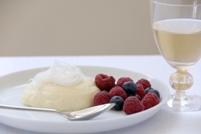Creamy Desserts
Tammy McLeod
 It really does feel like spring has sprung and with the lighter evenings and warmer days comes a longing for fresher, lighter desserts – desserts which complement the other tastes of spring (lamb, asparagus and strawberries) and leave you feeling pleasantly full, rather than weighted down like the comfort puddings of winter.We often order delicious desserts such as panna cotta, crème brulee and crème caramel in restaurants, but are too timid to try them at home. However, these desserts are incredibly achievable and you will delight your guests and yourself with your cooking prowess.
It really does feel like spring has sprung and with the lighter evenings and warmer days comes a longing for fresher, lighter desserts – desserts which complement the other tastes of spring (lamb, asparagus and strawberries) and leave you feeling pleasantly full, rather than weighted down like the comfort puddings of winter.We often order delicious desserts such as panna cotta, crème brulee and crème caramel in restaurants, but are too timid to try them at home. However, these desserts are incredibly achievable and you will delight your guests and yourself with your cooking prowess.
Panna Cotta is one of my favourite summer puddings. The name literally means “cooked cream” in Italian. There are hundreds of rich variants, but my standard panna cotta recipe has a yoghurt base, which makes the finished product slightly tart and a little less heavy for those watching their waistlines! It is simply made by heating cream and sugar with a flavouring (a split vanilla pod is my favourite but you could also try crushed cardamom pods, cinnamon, dissolved espresso coffee, lemon or orange zest) until it reaches boiling point, then once this mixture has cooled a little, add either soaked gelatine leaves, or gelatine powder dissolved in a little warm water and thick natural yoghurt equal to the amount of cream you use. I find the ratio of 1 tsp gelatine or gelatine sheet to 100ml each of cream and yoghurt gives the desirable “jelly wobble” set – you don’t want your panna cotta set hard. Remember also that gelatine firms with time so if you are making a day ahead then start out with more wobble than you would like. Strain out your flavouring, pour into ramekins and chill for at least four hours. You can serve these delicious puddings with little dipping biscuits such as biscotti or tuiles.
Crème Anglaise is a “real” egg custard. Once you have mastered the art of making custard (bring your cream, milk (if using) and sugar to boiling point, pour over whisked egg yolks and then re-heat in a double boiler until a thick custard forms), the world of ice-cream, crème brulee and crème caramel is at your feet.
Crème Brulee is a delicious twice cooked version of crème Anglaise, with a crunchy toffee coating. To turn your crème anglaise into a crème brulee, pour the cooked custard into little ramekins or a shallow baking dish and bake, covered in tinfoil, in a bain marie until set. You then chill the custards, cover the tops liberally with sugar and caramelise them with a brulee torch or under a hot grill. The more shallow your baking dish, the greater the proportion of toffee to creamy filling. Crème Brulee is extraordinarily versatile and you can ring the changes by adding different infusions to the cream (as for panna cotta), placing berries or other dried or stewed fruit in the base of the ramekins or even replacing some of the cream with coconut cream or a little espresso coffee. You could also try cooking the custard in a shortcrust tart case and bruleeing the top.
A traditional Spanish dessert, crème caramel, also uses crème Anglaise as a base, but is almost like a crème brulee in reverse – the caramel is on the bottom, so that when you invert the puddings, you are left with the delicious cooked custard surrounded by a pool of caramel. As with panna cotta, the best crème caramels are set with a slight wobble and smooth, creamy texture. My preference is to cook the crème caramels in little ramekins, as it is easier to keep little puddings in one piece when inverting them. These are fabulous as is or served with a fresh fruit salad (think passionfruit, berries or kiwifruit) to cut through the richness.


